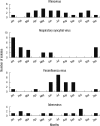Respiratory viral infections after hematopoietic stem cell transplantation in children
- PMID: 23341709
- PMCID: PMC3546101
- DOI: 10.3346/jkms.2013.28.1.36
Respiratory viral infections after hematopoietic stem cell transplantation in children
Abstract
This study was performed to characterize respiratory viral infections in pediatric patients undergoing hematopoietic stem cell transplantation (HSCT). Study samples included 402 respiratory specimens obtained from 358 clinical episodes that occurred in the 116 children of the 175 consecutive HSCT cohort at Seoul National University Children's Hospital, Korea from 2007 to 2010. Multiplex reverse-transcription polymerase chain reactions were performed for rhinovirus, respiratory syncytial virus (RSV), parainfluenza viruses (PIVs), adenovirus, human coronavirus (hCoV), influenza viruses and human metapneumovirus. Viruses were identified in 89 clinical episodes that occurred in 58 patients. Among the 89 clinical episodes, frequently detected viruses were rhinovirus in 25 (28.1%), RSV in 23 (25.8%), PIV-3 in 16 (18.0%), adenovirus in 12 (13.5%), and hCoV in 10 (11.2%). Lower respiratory tract infections were diagnosed in 34 (38.2%). Neutropenia was present in 24 (27.0%) episodes and lymphopenia was in 31 (34.8%) episodes. Sixty-three percent of the clinical episodes were hospital-acquired. Three patients died of respiratory failure caused by respiratory viral infections. Respiratory viral infections in pediatric patients who have undergone HSCT are common and are frequently acquired during hospitalization. Continuous monitoring is required to determine the role of respiratory viruses in immunocompromised children and the importance of preventive strategies.
Keywords: Hematopoietic Stem Cell Transplantation; Respiratory Infections; Respiratory Virus.
Figures
Similar articles
-
Detection of respiratory syncytial virus, parainfluenzavirus 3, adenovirus and rhinovirus sequences in respiratory tract of infants by polymerase chain reaction and hybridization.Clin Diagn Virol. 1997 May;8(1):31-40. doi: 10.1016/s0928-0197(97)00060-3. Clin Diagn Virol. 1997. PMID: 9248656
-
CAUSATIVE AGENTS OF SEVERE COMMUNITY ACQUIRED VIRAL PNEUMONIA AMONG CHILDREN IN EASTERN THAILAND.Southeast Asian J Trop Med Public Health. 2015 Jul;46(4):650-6. Southeast Asian J Trop Med Public Health. 2015. PMID: 26867384
-
[Simultaneous detection of respiratory viruses and influenza A virus subtypes using multiplex PCR].Mikrobiyol Bul. 2014 Oct;48(4):652-60. doi: 10.5578/mb.8221. Mikrobiyol Bul. 2014. PMID: 25492660 Turkish.
-
Fourth European Conference on Infections in Leukaemia (ECIL-4): guidelines for diagnosis and treatment of human respiratory syncytial virus, parainfluenza virus, metapneumovirus, rhinovirus, and coronavirus.Clin Infect Dis. 2013 Jan;56(2):258-66. doi: 10.1093/cid/cis844. Epub 2012 Sep 28. Clin Infect Dis. 2013. PMID: 23024295 Free PMC article. Review.
-
Pitfalls in definitions on respiratory viruses and particularities of Adenovirus infection in hematopoietic cell transplantation patients: Recommendations from the EBMT practice harmonization and guidelines committee.Curr Res Transl Med. 2024 Sep;72(3):103461. doi: 10.1016/j.retram.2024.103461. Epub 2024 Jul 14. Curr Res Transl Med. 2024. PMID: 39032263 Review.
Cited by
-
Respiratory Virus Infections in Hematopoietic Cell Transplant Recipients.Front Microbiol. 2019 Jan 9;9:3294. doi: 10.3389/fmicb.2018.03294. eCollection 2018. Front Microbiol. 2019. PMID: 30687278 Free PMC article. Review.
-
Prolonged respiratory viral shedding in transplant patients.Transpl Infect Dis. 2014 Feb;16(1):165-9. doi: 10.1111/tid.12167. Epub 2013 Dec 2. Transpl Infect Dis. 2014. PMID: 24289829 Free PMC article.
-
Respiratory syncytial virus infections in infants affected by primary immunodeficiency.J Immunol Res. 2014;2014:850831. doi: 10.1155/2014/850831. Epub 2014 Jun 25. J Immunol Res. 2014. PMID: 25089282 Free PMC article. Review.
-
Parainfluenza virus infections in hematopoietic cell transplant recipients and hematologic malignancy patients: A systematic review.Cancer Lett. 2016 Jan 28;370(2):358-64. doi: 10.1016/j.canlet.2015.11.014. Epub 2015 Nov 12. Cancer Lett. 2016. PMID: 26582658 Free PMC article.
-
Use of whole-genome sequencing in the molecular investigation of care-associated HCoV-OC43 infections in a hematopoietic stem cell transplant unit.J Clin Virol. 2020 Jan;122:104206. doi: 10.1016/j.jcv.2019.104206. Epub 2019 Nov 16. J Clin Virol. 2020. PMID: 31783264 Free PMC article.
References
-
- Walter EA, Bowden RA. Infection in the bone marrow transplant recipient. Infect Dis Clin North Am. 1995;9:823–847. - PubMed
-
- Carlson K, Backlund L, Smedmyr B, Oberg G, Simonsson B. Pulmonary function and complications subsequent to autologous bone marrow transplantation. Bone Marrow Transplant. 1994;14:805–811. - PubMed
-
- Henderson FW, Clyde WA, Jr, Collier AM, Denny FW, Senior RJ, Sheaffer CI, Conley WG, 3rd, Christian RM. The etiologic and epidemiologic spectrum of bronchiolitis in pediatric practice. J Pediatr. 1979;95:183–190. - PubMed
-
- Yun BY, Kim MR, Park JY, Choi EH, Lee HJ, Yun CK. Viral etiology and epidemiology of acute lower respiratory tract infections in Korean children. Pediatr Infect Dis J. 1995;14:1054–1059. - PubMed
-
- Whimbey E, Bodey GP. Viral pneumonia in the immunocompromised adult with neoplastic disease: the role of common community respiratory viruses. Semin Respir Infect. 1992;7:122–131. - PubMed
Publication types
MeSH terms
LinkOut - more resources
Full Text Sources
Other Literature Sources


